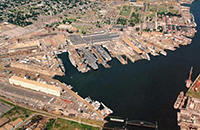Norfolk Naval Shipyard
In 1767, the Norfolk Naval Shipyard was established, making it the oldest existing shipyard in the U.S. to focus on ship repair and overhaul. The yard’s mission is to support the Naval Fleet by providing logistical support; overhauling and repairing ships; manufacturing materials and researching to develop and test new materials; and providing services and material to other units.

About Norfolk Naval Shipyard
From 1940 to 1945, the yard worked on 6,850 naval vessels. They also built 101 new ships and landing crafts for the Navy Fleet. Plus, they made special products used on bases and onboard Navy ships.
Norfolk Naval Shipyard gave a lot of help to the war effort. Unfortunately, this polluted landfills with asbestos materials. The Paradise Creek Landfill from 1945 to 1983 received asbestos waste. Another landfill near the shipyard received asbestos waste from 1927-1941.
Norfolk Naval Shipyard is the oldest existing shipyard in America. It has a long history of asbestos use. During ship construction and repair, people had to work in small spaces. Unfortunately, this led to asbestos exposure. Asbestos is a mineral that can cause lung cancer, asbestosis and mesothelioma.
The International Journal of Environmental Health Research published a review in 2021. It looked at the risk of cancer from asbestos exposure among sailors. Research showed that seafarers from five Nordic countries had more than double the risk of mesothelioma.
Norfolk Naval Shipyard is on the EPA’s National Priorities List
The EPA decided to add the yard to its National Priorities List because of the amount of contamination from asbestos. The shipyard also has industrial shops. They do metal forming, repair work, fabricate metal parts, plate them with metal and paint them.
This type of heavy industrial work produces a lot of waste, including asbestos, metal scraps, oils from machines and other chemicals. Before 1979, people used to throw these materials overboard or onto the ground. Before they had an industrial waste treatment plant, some shop wastes went down storm drains. It ended up in the Elizabeth River without any special cleaning.
People also didn’t take safety seriously and used dangerous materials. Asbestos exposure in the yard caused some workers to develop mesothelioma and other diseases.

Learn about your diagnosis, top doctors and how to pay for treatment.
Get Your Free GuideMesothelioma Rates are Higher at Norfolk
A 1991 report was prepared by Johns Hopkins University School of Hygiene and Public Health. It evaluated low-level radiation exposure among shipyard workers. They overhauled nuclear propulsion plants in six facilities. This included Norfolk. The researchers studied the mortality from mesothelioma among this population.
The number of deaths from cases with confirmed pleural or peritoneal mesothelioma was small. But that’s because it is a rare form of cancer. The incidence rate was actually higher than in the general population of white males. Mesothelioma deaths were higher in radiation-exposed workers than in non-exposed workers. This led to the conclusion that nuclear workers held more jobs with the potential for asbestos exposure.
Recommended Reading


